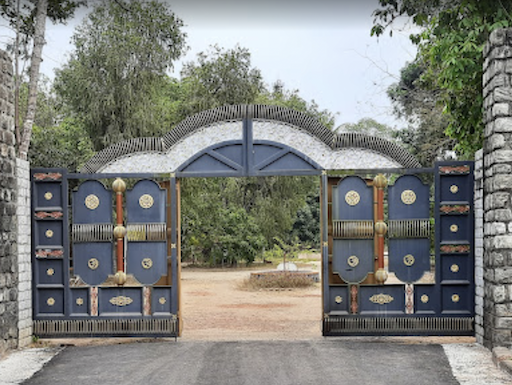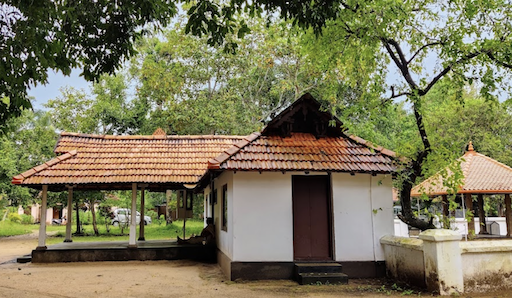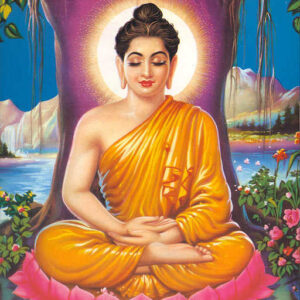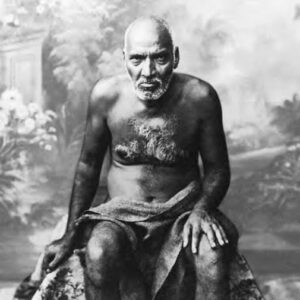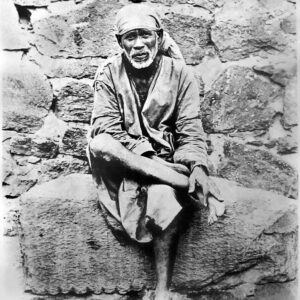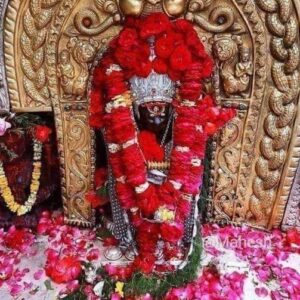This is a Samadhi of Sree Chattambi Swamikal. The samadhi is inside a small temple in the premises of Panmana Ashram.
There is a place to sit and meditate next to the Samadhi. You can go into meditative states here effortlessly.
How to get there
This Jeevasamadhi is located 23 kms North of Kollam. Regular buses are available between Kollam and Panmana Ashram.
Map: https://goo.gl/maps/4DhADhxzyynxbF4q9
About Sree Chattambi Swamikal
THE DIVINE GLORY OF SREE CHATTAMPI SWAMIKAL
PARAMA BHATTARA SREE VIDYADHIRAJA CHATTAMPI SWAMIKAL (1853 – 1924), the great peripatetic scholar, lived in Kerala, the southernmost state of India. His religious quest and discovery, his austere simplicity and great self-denial, his humble sharing with others the light with which he himself was illumined, his loving tenderness for all living creatures are all inspiring and instructive for all time.
CHATTAMPI SWAMIKAL, as he is popularly known, was not an organiser or a propagandist. He strictly adhered to the characteristic virtues of an ideal sage practising Ahimsa (Non-violence), Sathya (Truthfulness), Asteya (Non-stealing), Brahmacharya (Celibacy) and Aparigraha (Non-Acquisition) as an exemplar of this mode of life. His influence widened the vision of many and imparted self-confidence to innumerable people, leaving a mark in the religious attitude of a large section of people.
Material deprivation failed to dampen his spirit and penury could not hamper Swamikal from becoming a mastermind by his own latent genius and prodigious intellectual industry. In spite of the narrow and restrictive conventions that existed in his times, he mastered many branches of art and learning. His painstaking study of Tamil and Sanskrit from competent scholars outside Kerala gave him remarkable command over Vedanta. His gifted mind found no rest till his proficiency in Yoga measured up to ostensible results. He travelled miles and miles on foot in search of knowledge, and when he acquired it, he wandered again as the inspirer of people. Chattampi Swamikal strove to educate people in egalitarian doctrines and to liberalize traditional religious ritual practices by his writings and example.
He was the precursor of many liberal trends, but he was not an avowed social reformer. While exposing the sacerdotal pretensions of the high priests of society and demolishing the arrogant claims of the top rungs in the ladder of caste hierarchy, in his polemical writings, he never precipitated inter-communal envy or bickerings. He was urged by a sense of historical justice rather than personal pride. He always extended his hands to those below him to raise them up. His vision of unity (Samadarsana) was the outcome of his vedantic conviction that Atman is Brahman, that each man is potentially divine and that all existence is one: the essence of Vedantic Wisdom.
Saints are the common property of humanity. The Spheres of their activities are, by and large, confined to particular regions. It is for us to make available knowledge of their life and ideas prevalent in one region to others also, across the barrier of language and time. By doing so we aid the emotional integration of mankind.
A Perfect Jeevanmukta
A Jeevanmukta is the liberated individual who while still living in the physical body is not conditioned by the limitation of his gross constitution and believes the entire universe to be the manifesation of the Absolute or his highest self. Such great souls see and experience Brahma Tattwa in a Brahmin, a cow, an elephant, a dog and the one who eats a dog, all alike without any distinction. They enjoy the Bliss of Self at all times and roam about for the well being of humanity at large. When their Prarabdha Karmas are over, they cast off their bodies, and the Jeevan dissolves in the Absolute Brahman.
Sree Chattampi Swamikal was such a Jeevanmukta with Sarvatra Samadarsan. (Experiencing unity in all)
His Mahasamadhi
Swamikal didn’t settle down at any particular place. Towards the end of his life, he revisited places like Thiruvananthapuram as if bidding farewell to them. He settled down at Panmana, a village 18km north of Kollam, enjoying the services rendered by his disciple Sree Kumpalathu Sanku Pillai, a young and spirited freedom fighter. Hundreds of people used to visit him to have his darshan and seek his advice and blessings. He used to receive them all with warmth. Gradually all the infirmities of old age began to attack him. He used to remind his disciples that all the ills that the flesh is destined to endure have to be endured before the soul would secure its release. He prophesied the time of his final departure though many could not understand it. When the final moment came Swamikal sat himself in Padmasana and mediated on Brahman. In that pose, in a few seconds, Swamikal entered into Eternal Samadhi at 4 pm on 5 May 1924. His mortal body was laid to rest at the place he had already selected for it. At the Samadhi Peedom a Sivalinga was installed as he had instructed.
Read More
https://www.panmanaashram.com/aspx/viewContent.aspx?linkId=83

